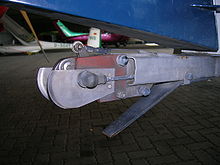Tow coupling
|
|
This article was due to substance or form defects on the quality assurance side of the portal Aviation entered. This is done in order to bring the quality of the articles from the topic of aviation to an acceptable level. Articles that cannot be significantly improved are deleted. Please help to resolve the shortcomings in this article and please participate in the discussion . |

A tow coupling is a device for attaching a tow rope.
Gliders , hang-gliders or paragliders need a tow coupling in order to be started in a rubber rope launch , aircraft towing or winch launch. The pilot can open the tow release to release the tow rope. Depending on the type of start, there are different types of tow release. With hang gliders and paragliders, tow couplings are called tow latches .
On the tow plane
In addition to the towing device, the tow plane needs a rearview mirror.
Aircraft tow coupling
At the towing aircraft is an aircraft tow release mounted at the rear, and in the tow rope is suspended before the start. It can be opened from the cockpit to release the tow rope above the airfield or, in an emergency, outside the field.
Pull-in device
In this form of towing device, the towing rope is rolled up on a rope drum. This rope is led out at the tail of the aircraft and pulled out to the stop for towing. When the tow is over, the pilot pulls the tow rope in electrically and saves the overflight to drop the rope. There is also a cutting device in the fuselage so that the rope can be cut in an emergency
On the towed aircraft
Nose hitch

The nose coupling is only used for aircraft towing. It is located at the nose of the glider to be towed.
The nose hitch essentially consists of a movable hook that is kept closed by a strong spring. To hang the tow rope in the coupling, the pilot must first open the hook from the cockpit against the resistance of the spring. Then the helper can insert the metal ring at the end of the rope into the indentation provided. The pilot then lets the hook snap back into its starting position, in which he now holds the ring.
Now the glider can be pulled up by the tow plane . When the desired altitude is reached, the pilot opens the clutch and the rope is released from the glider. The tow plane releases it over the airfield or pulls it in with a retraction device.
Center of gravity coupling
The center of gravity coupling also has a hook that can be opened manually by the pilot and a retaining ring that holds the ring in position at the end of the tow cable under tension. The ring is spring-loaded and automatically releases the rope when the tension is released and the rope exceeds a certain angle to the rear.
The tow rope for a winch start or for an aircraft tow is attached to this coupling , on which the aircraft is accelerated and pulled up. When the disengagement point or the desired flight altitude is reached, the clutch is opened and the rope is released from the aircraft.



